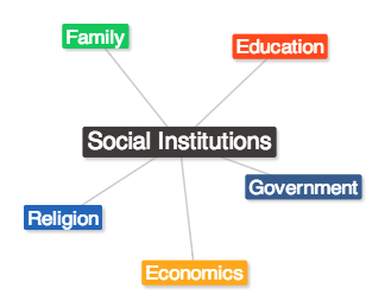Imagine a world without rules. Imagine not knowing what to expect from your teacher, your boss, or even your parents. Imagine the chaos of a random, unorganized society where everyone acts on their individual whims. This is a world without social institutions, the invisible but powerful structures that guide our behaviors and shape our lives.

Image: genderedinstitutions.weebly.com
Social institutions are more than just abstract concepts; they are the foundations upon which our society is built. They provide guidelines, expectations, and systems that shape our interactions with the world. Understanding social institutions is not just an academic exercise; it is crucial to navigating our lives and making sense of the world around us.
What are Social Institutions?
Social institutions are a central concept in sociology. Sociologists define them as stable and enduring patterns of social behavior organized around particular purposes. They provide a framework for how we live, interact, and make sense of the world.
Let’s break down this definition further:
- Stable and enduring patterns of social behavior: Social institutions are not fleeting fads. They have evolved over time, often rooted in deeply held beliefs and traditions. They remain relatively constant, providing a sense of stability and predictability.
- Organized around particular purposes: Social institutions serve specific functions in society. For example, the institution of marriage unites individuals and families, while the institution of education imparts knowledge and skills.
Key Examples of Social Institutions
Some prominent examples of social institutions include:
- Family: The family institution provides a foundation for socialization, caregiving, and emotional support. It establishes norms for kinship, inheritance, and child-rearing.
- Education: The educational institution aims to transmit knowledge, skills, and values to the next generation. It prepares individuals for work, citizenship, and participation in society.
- Religion: Religion provides moral guidelines, rituals, and a sense of community. It offers explanations for the world and provides comfort during challenging times.
- Economy: The economic institution focuses on the production, distribution, and consumption of goods and services. It governs labor markets, property rights, and the allocation of resources.
- Government: The government institution provides rules, laws, and authority to maintain order and protect the rights and wellbeing of its citizens.
The Interplay of Social Institutions
It’s essential to recognize that social institutions do not exist in isolation. They are interconnected and interdependent, influencing and shaping each other. For instance, the education system is influenced by the economic system, as societal demands for skilled workers shape the curriculum and learning goals. Similarly, the government regulation of families, such as laws pertaining to marriage and adoption, also reflects broader societal values and shifts in beliefs over time.

Image: www.pinterest.com
Social Institutions and Social Change
While social institutions are designed to offer stability, they are also subject to change. Social movements, technological advancements, and evolving societal values can all lead to shifts in the norms and structures of institutions. For example, the LGBTQ+ movement has challenged traditional norms and expectations surrounding family and marriage, leading to significant changes in societal attitudes and legal recognition.
Understanding Social Institutions: Why It Matters
Examining social institutions gives us a powerful lens through which to understand social dynamics. Here’s why this understanding is crucial:
- Clarifying Individual Experiences: Analyzing social institutions helps us recognize how the rules, values, and structures that surround us shape our experiences and expectations. Instead of simply accepting these norms as given, we can begin to critically analyze their influence on our lives.
- Identifying Social Problems: Recognizing how social institutions function can help us identify social problems and inequalities. For instance, by examining the institutions of education, healthcare, and the justice system, we can uncover systemic disparities in access to resources and opportunities.
- Promoting Social Change: Understanding the role of social institutions is essential for advocating for change. By recognizing the ways in which institutions perpetuate existing inequalities, we can work towards creating more just and equitable societies.
Expert Insights for Navigating the World of Social Institutions
Sociologists offer insightful perspectives for navigating the intricate world of social institutions:
- Dr. Juliet Schor, a renowned sociologist and author, suggests that we engage in “creative adaptation” of social institutions. This means taking the existing structures and modifying them to fit our needs and values, rather than simply accepting them as immutable.
- Dr. Michael Burawoy, a leading figure in sociological research, emphasizes the importance of “critical reflection” on social institutions. This involves questioning the underlying assumptions, values, and power dynamics that shape these institutions to uncover hidden biases and potential for change.
Taking Action: Engaging with Social Institutions
You can actively engage with social institutions and shape their impact on your life:
- Become an informed citizen: Stay informed about social issues related to institutions. Research different perspectives, participate in dialogues, and vote to express your views on how institutions function.
- Advocate for change: Identify institutions that contribute to inequalities or injustices and advocate for reforms, policy changes, or social movements to address these issues.
- Embrace creative adaptation: Experiment with adapting existing social structures to meet your needs while respecting the norms and values of those around you.
What Is Social Institution In Sociology
Conclusion
Understanding social institutions is a crucial step towards navigating the complexities of life, identifying social problems, and advocating for positive change. These structures provide the framework for our interactions and shape our experiences, but they are also subject to constant evolution and reform. By engaging with institutions, becoming informed about their impact, and embracing creative adaptation, we can collectively work to create a more equitable and just society for all.






